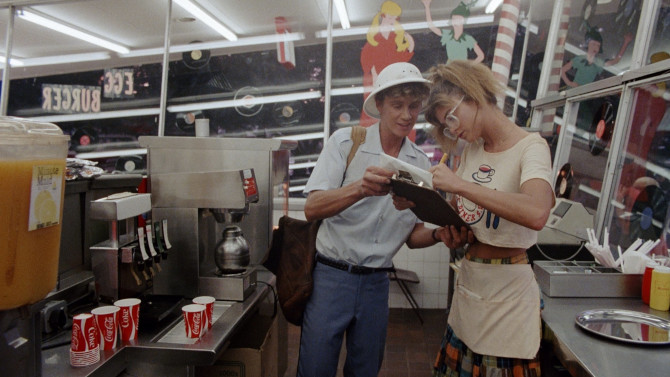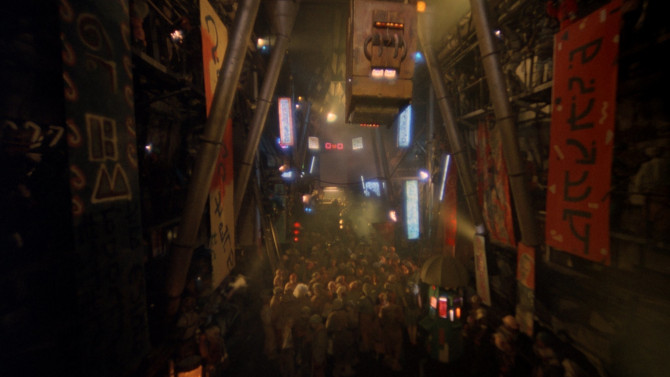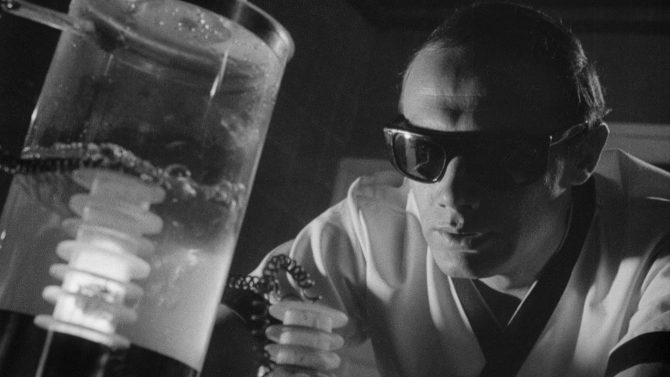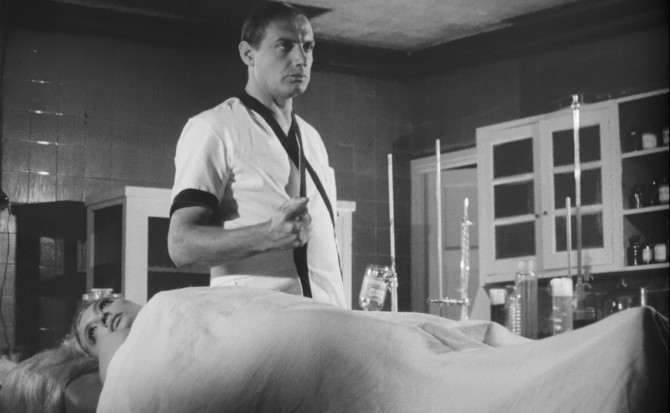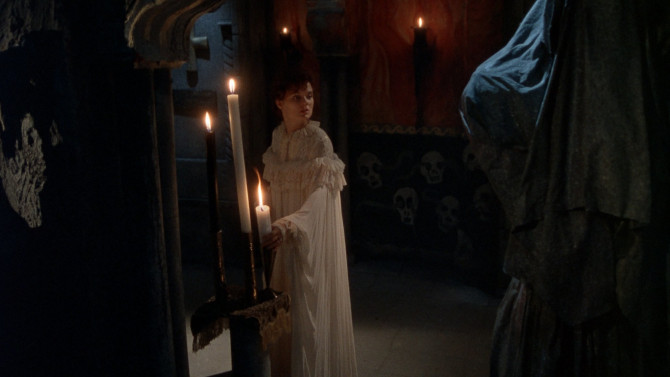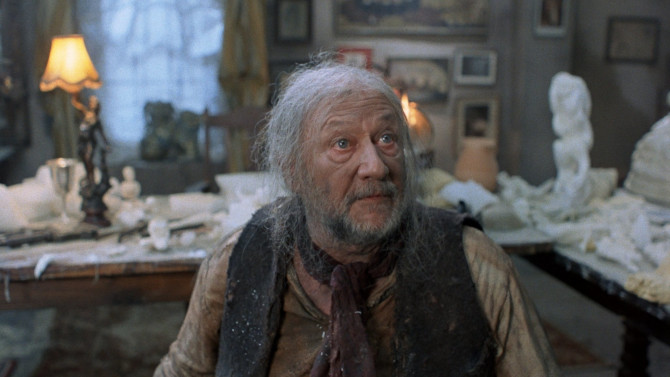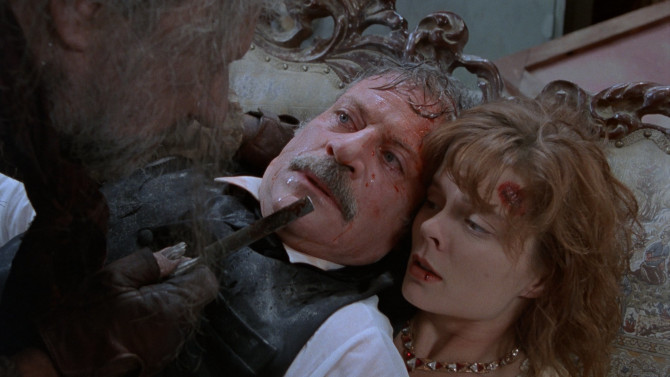Part 3 of my Missed the Bloody Cut horror selections, here are some more horror movies that did not meet my strict criteria (a rating of 7.0 or higher). . . but are still entertaining films (horror fanatics may enjoy) that do not deserve to be left behind like an alien who needs to phone home – and that they are definitely worth a watch (just maybe not several re-watches).
More horror in title than in execution, 1988’s Alien from L.A., co-written and directed by Albert Pyun, is a sci-fi fairytale adventure in the vein of the famed Jules Verne novel Journey to the Center of the Earth, fused with a dystopic piece of world building reminiscent of Blade Runner.
Of course, this is one of those same old stories – an archaeologist father, Professor Arnold Saknussemm (Richard Haines) falls down a bottomless pit and dies. . . his daughter, Wanda (supermodel Kathy Ireland), is contacted by the man’s friend in North Africa – a bartender named Mahoney (seems likely). If you’ve seen it once, you’ve seen it a thousand times. And sometimes it’s just not your week. . . for Wanda’s boyfriend has broken up with her – citing her fear of cars and planes, her bland demeanor, her blah brown hair (you’ve clearly got to be blonde in California), too thick glasses, and let’s not forget her unbelievably squeaky voice.
Finally deciding to leave her confines and explore North Africa – hoping to track down her father in some hole in the wall, her clumsy ways find her falling down the same bottomless pit – I guess the saying can be changed to ‘like father like daughter’. Landing in some sort of habitable underground cavern, she soon realizes that people are living there. . . could it be the alien breed of Atlantians that her father had hypothesized? In any case, she rescues a miner with the unearthly name of Gus (William R. Moses), who brings her to a massive city. Soon realizing that the tyrannical government system believes any over-dwellers must be spies that should be nabbed, Wanda will have to be sharp (she won’t be), though perhaps she can use her shrill voice to keep these quasi-humans away from her.
Though the story flounders (staid, to say the least), the cavernous world is actually quite impressive. Partially filmed in underground mines and the gold fields of South Africa, it has a dystopic, sci-fi vibe to it. . . though not as impressive as Blade Runner, it certainly has that feel. With kaleidoscopic colours (harsh reds, oranges, greens, and blues), practical effects, visual trickery, and creative sets, it is easy on the eyes, though not the ears (there’s that squeaky voice again). In fact, a few of the shots of Wanda moving through her father’s catacomb have a Morlock-like look from the original The Time Machine (1960) – her glasses giving her hyper-stylized eyes that make for a really striking effect.
Despite the fact there’s not much need to journey to Atlantis for the story, what makes the trek worthwhile are the creative visuals and Dayglo cinematography constructed by Pyun and his team. And though Alien from L.A. might just sound like an oxymoron (after all, it is called Planet Hollywood), that might just help her fit into this quaky underground world. So, enjoy this visit to North Africa (which is actually South Africa), and see this alien from L.A. meet real aliens from Atlantis – though none of it makes much sense, just go with it (it will be easier on the brain, but not the ears).
* * *
When you hear an unusual title like The Curious Dr. Humpp, your brain will likely think of one of three things: perhaps you’ll say something along the lines of – this poor doctor must be deformed like Igor in Young Frankenstein; instead, maybe you’ll suspect that this titular character must be a dirty, dirty dog; or you might just be saying – ah, this good fellow must be German.
Horror sexploitation at its breast, this 1969 black and white Argentine export, written and directed by Emilio Vieyra, will have you wondering if all three of the above statements might just be true. For the industrious and nutty as a fruitcake Dr. Humpp (Aldo Barbero) is kidnapping highly sexualized teens for his sordid experiments (a silent film-like intro finds numerous people – with the awareness of a gnat, being nabbed by the doctor’s disfigured, mind-controlled henchmen). On the track to discovering a ‘fluid’ that will bring back youthfulness. . . and hopefully eternal life, I’m not quite sure if we really want to know what the madman is drinking – it’s definitely not blood (which somehow might be better). Using it to keep him healthy, two things are clear – the potion is covering up something horrific (it could be that above mentioned deformity), and second, clearly no concoction can help him with those horrible bangs. And, to quickly touch on that third and final hypothesis about him being German – it very well could be, after all, many Nazis fled to South America after World War II.
Of course, it is not the police, but rather a newspaper reporter, George (Ricardo Bauleo), who has stumbled upon this sordid story. Bringing it to said cops, Inspector Benedict (Héctor Biuchet), finds it hard to believe that someone is jaculating teens in town. . . only then to hold them against their will. Again, it will be George doing the dirty work, tracking down the doctor’s private residence – discovering it is guarded by a number of mind controlled minions, as well as one somehow uglier henchman – though he does wear a fetching sweater (eyes permanently crossed in the opposite from normal direction – that must be what happens when you see that much sex all the time).
Finding himself in the same predicament as all the trapped teens, George is placed in a room with sultry stripper Raquel (Gloria Prat), while he is ‘cared for’ by blonde nurse Enfermera (Susana Beltrán). Eventually finding a way to get the message out to the Inspector, will the lobcock Benedict be able to stumble his way to the doctor’s lair and help save the day? And, perhaps more importantly, is all of this hoopla from the mad doctor simply to cover up that he’s a pervert who, for some reason, likes bodily fluids?
Though absolutely mindless drivel, The Curious Dr. Humpp is an eyeful to look at – steamy sexploitation, striking black and white cinematography, and we actually find out the brains behind Dr. Humpp’s entire operation – in fact, it turns out to be a talking brain (talk about all brain and no brawn). It is also backed by a most bizarre score by Víctor Buchino, part swinging jazz music, part psychedelic horror composition. In the end, it is a curio of cult cinema to be sure – absurdly quirky, quacky quackery, and unintentionally funny (where else will you get dialogue like: “Sex dominates the world! And now, I dominate sex!”, or “I love you, Doctor! Give it to me!”. . . exclamation point overload). So, check out this curious case if you dare, but beware, it might make a slave of you.
* * *
A modernized take on one of Edgar Allan Poe’s short stories, 1989’s The House of Usher, directed by Alan Birkinshaw, might have you wishing that they had ushered in something a bit scarier.
Paling in comparison to the original source material. . . disappointing when you look at some of the cast members gathered for it, newly engaged Ryan (Rufus Swart) and Molly (Romy Walthall) have accepted an invitation from Ryan’s eccentric uncle, Roderick Usher (Oliver Reed – at his stuffy and aberrant best). Trusting in someone they have never met (these Americans making their first trek to England), the couple soon find their car hood meeting tree. . . two ghostly pale girls causing the accident. If not enough of a warning, Molly spots the gloomy manor residence. . . looking for help for her unconscious husband.
What she finds in the slowly collapsing mansion, outside of its pagan chic design fused with gothic crumble, is a menacing butler, Clive (Norman Coombes), his disenchanted wife (Anne Stradi) – a horrible cook (which might just be the scariest aspect of this film), and their mute daughter, Gwen (Carole Farquhar). She will also soon find Roderick’s brother Walter (Donald Pleasence), a man who has a drill attached to his hand (you’ve got to have hobbies) and is cloistered away in a locked room.
Finding herself a guest of honor. . . and by that, I mean she can’t leave, Roderick is soon telling her that Ryan died from his minor wounds, but that she can help him continue the line of Usher – nothing like a marriage and pregnancy proposal after finding out your husband has been killed. But, let’s face it, he is a catch – he hates any smells, can only tolerate a few colours, has a manor that is crumbling, carries with him a rare blood disorder that is passed along to any offspring, is quick to anger, and might just have murdered his nephew to woo the widow. With no seeming escape, will Molly accept the indecent proposal? Might she try to manipulate her many captors instead? Or could the cooking kill her off before anything else happens?
With two legends of the genre clearly having a fun time, both Reed and Pleasence are a joy to watch. . . even if the atmosphere leaves a lot to be desired. Though the set, filled with maze -like secret passages, is actually quite impressive, the horror never really builds to anything palpable (it doesn’t help that you can see the cords attached to pull items down). Though it is really funny that Molly’s mom is an Avon salesperson when Roderick hates any scents.
Watchable thanks to its entertaining cast, The House of Usher crumbles under the weight of its source material. . . never as atmospheric as even the opening lines of Poe’s tale. It might also have you wondering where the ‘Fall of’ disappeared to – as that was in the original title. So, it’s up to you to decide whether you want to usher in, or is it fall for, this renovation project. . . it gives new meaning to the term crack house.


